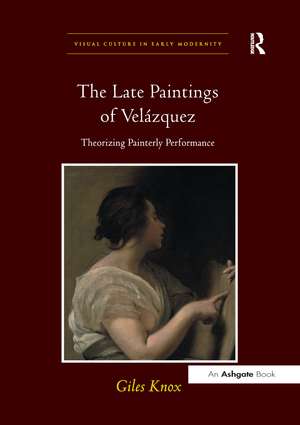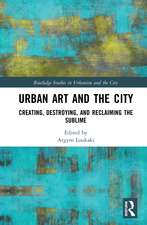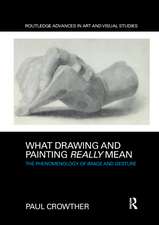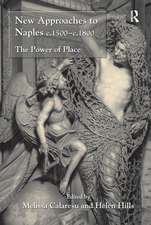The Late Paintings of Velázquez: Theorizing Painterly Performance: Visual Culture in Early Modernity
Autor Giles Knoxen Limba Engleză Paperback – 31 oct 2016
| Toate formatele și edițiile | Preț | Express |
|---|---|---|
| Paperback (1) | 324.16 lei 6-8 săpt. | |
| Taylor & Francis – 31 oct 2016 | 324.16 lei 6-8 săpt. | |
| Hardback (1) | 819.90 lei 6-8 săpt. | |
| Taylor & Francis – 18 mai 2009 | 819.90 lei 6-8 săpt. |
Din seria Visual Culture in Early Modernity
- 26%
 Preț: 324.16 lei
Preț: 324.16 lei - 18%
 Preț: 1061.84 lei
Preț: 1061.84 lei -
 Preț: 311.37 lei
Preț: 311.37 lei - 9%
 Preț: 1022.27 lei
Preț: 1022.27 lei -
 Preț: 312.12 lei
Preț: 312.12 lei -
 Preț: 356.70 lei
Preț: 356.70 lei -
 Preț: 336.27 lei
Preț: 336.27 lei -
 Preț: 432.98 lei
Preț: 432.98 lei - 17%
 Preț: 343.55 lei
Preț: 343.55 lei - 25%
 Preț: 324.16 lei
Preț: 324.16 lei - 30%
 Preț: 769.92 lei
Preț: 769.92 lei - 17%
 Preț: 338.33 lei
Preț: 338.33 lei - 22%
 Preț: 259.98 lei
Preț: 259.98 lei - 25%
 Preț: 326.11 lei
Preț: 326.11 lei -
 Preț: 471.08 lei
Preț: 471.08 lei - 28%
 Preț: 826.84 lei
Preț: 826.84 lei - 28%
 Preț: 819.90 lei
Preț: 819.90 lei - 28%
 Preț: 878.42 lei
Preț: 878.42 lei - 28%
 Preț: 829.69 lei
Preț: 829.69 lei - 25%
 Preț: 325.43 lei
Preț: 325.43 lei - 30%
 Preț: 853.03 lei
Preț: 853.03 lei - 17%
 Preț: 339.96 lei
Preț: 339.96 lei - 30%
 Preț: 830.92 lei
Preț: 830.92 lei - 16%
 Preț: 338.33 lei
Preț: 338.33 lei - 30%
 Preț: 826.02 lei
Preț: 826.02 lei - 30%
 Preț: 772.60 lei
Preț: 772.60 lei - 18%
 Preț: 1017.63 lei
Preț: 1017.63 lei - 30%
 Preț: 768.62 lei
Preț: 768.62 lei - 17%
 Preț: 338.33 lei
Preț: 338.33 lei - 30%
 Preț: 771.07 lei
Preț: 771.07 lei - 26%
 Preț: 324.84 lei
Preț: 324.84 lei - 30%
 Preț: 772.76 lei
Preț: 772.76 lei - 16%
 Preț: 347.33 lei
Preț: 347.33 lei - 31%
 Preț: 765.03 lei
Preț: 765.03 lei -
 Preț: 489.26 lei
Preț: 489.26 lei - 28%
 Preț: 822.91 lei
Preț: 822.91 lei - 18%
 Preț: 300.09 lei
Preț: 300.09 lei - 28%
 Preț: 820.73 lei
Preț: 820.73 lei - 28%
 Preț: 829.69 lei
Preț: 829.69 lei - 28%
 Preț: 826.84 lei
Preț: 826.84 lei - 30%
 Preț: 776.03 lei
Preț: 776.03 lei
Preț: 324.16 lei
Preț vechi: 439.54 lei
-26% Nou
Puncte Express: 486
Preț estimativ în valută:
62.05€ • 67.42$ • 52.15£
62.05€ • 67.42$ • 52.15£
Carte tipărită la comandă
Livrare economică 21 aprilie-05 mai
Preluare comenzi: 021 569.72.76
Specificații
ISBN-13: 9781138274648
ISBN-10: 113827464X
Pagini: 208
Dimensiuni: 174 x 246 x 14 mm
Greutate: 0.45 kg
Ediția:1
Editura: Taylor & Francis
Colecția Routledge
Seria Visual Culture in Early Modernity
Locul publicării:Oxford, United Kingdom
ISBN-10: 113827464X
Pagini: 208
Dimensiuni: 174 x 246 x 14 mm
Greutate: 0.45 kg
Ediția:1
Editura: Taylor & Francis
Colecția Routledge
Seria Visual Culture in Early Modernity
Locul publicării:Oxford, United Kingdom
Cuprins
Contents: Introduction; Critical responses to painterly painting; An allegory of painterly painting; The Spinners and the triumph of Venice; The Spinners: a witty critique; Las Meninas: social and structural perspectives; Las Meninas: painterly polemics; Select bibliography: Index.
Notă biografică
Giles Knox is an Assistant Professor in the Department of the History of Art, Indiana University, USA.
Recenzii
Prize: Awarded an Honorable Mention in the Eleanor Tufts book prize competition, 2011, sponsored by the American Society for Hispanic Art Historical Studies (ASHAHS)
'The Late Paintings of Vel�uez is a comprehensive effort to treat some of the most important paintings by Vel�uez as part of a self-conscious strategy to locate his past and present work against a backdrop of seventeenth-century art theory polemics, on the one hand, and in relation to the narrative of the history of early modern painting as it had been set up in the canonical Lives of Giorgio Vasari, on the other.' Sixteenth Century Journal
'... an insightful contribution to Vel�uez Studies.' Bulletin of Spanish Studies
'The Late Paintings of Vel�uez is a comprehensive effort to treat some of the most important paintings by Vel�uez as part of a self-conscious strategy to locate his past and present work against a backdrop of seventeenth-century art theory polemics, on the one hand, and in relation to the narrative of the history of early modern painting as it had been set up in the canonical Lives of Giorgio Vasari, on the other.' Sixteenth Century Journal
'... an insightful contribution to Vel�uez Studies.' Bulletin of Spanish Studies
Descriere
This study argues that Diego Velázquez painted two of his most famous works, The Spinners and Las Meninas, as theoretically informed manifestos of painterly brushwork. Knox presents a Velázquez who was much more aware of the art theory of his era than previously acknowledged, leading to his new interpretation of these works as representing together a polemically charged celebration of the "handedness" of painting.


















